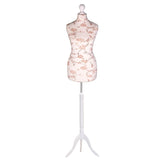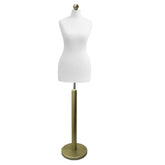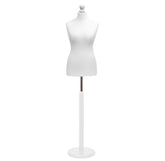Durable Garment Racks with Covers Your Ultimate Guide
Think of a garment rack with a cover as a pop-up wardrobe. It gives you all the benefits of an enclosed space—keeping your clothes organised and safe from dust, light, and moisture—but with the flexibility of a freestanding rack. It's the perfect middle ground, blending the portability of a rack with the protection of a closet.
The Modern Solution to Clothing Storage

Let’s be honest, we're all struggling for space. Overflowing wardrobes and cluttered bedrooms are a common headache, pushing us to find smarter ways to store our clothes. The traditional wardrobe is often a bulky, permanent fixture that just doesn't work for smaller rooms or for people who move around.
This is where garment racks with covers really shine. They're a practical and surprisingly stylish alternative, moving us away from static, fixed storage to something much more dynamic. A traditional wardrobe is like a built-in bookshelf—solid and permanent. A covered garment rack, on the other hand, is more like a modular shelving unit: you can adapt it, move it, and set it up to fit your life.
Beyond the Basic Wardrobe
These versatile pieces have officially moved out from behind the scenes at fashion shows and into our homes. They've become an essential tool for modern living, offering a smart blend of function and style. The real magic is in how they deliver top-notch protection and organisation without the commitment of a heavy, permanent piece of furniture.
What makes them so useful goes beyond just hanging up a few shirts:
- Flexibility: You can easily move them from room to room, take them with you when you move house, or just tuck them away when you don't need them.
- Protection: The cover is a brilliant shield against dust and sunlight, keeping the colour and quality of your clothes in pristine condition for much longer.
- Visual Calm: Hiding your clothes from view instantly creates a tidier, less cluttered, and more minimalist feel in any room.
A Fit for Every Lifestyle
Whether you're living in a compact city flat, a fashion lover with an ever-expanding collection, or just someone who needs a smart way to store seasonal clothes, a covered garment rack is an incredibly effective solution. They’re great for all sorts of situations, from setting up a temporary wardrobe in a guest room to managing costumes for a local theatre group.
To get a real sense of what's out there, it helps to weigh up different storage options. For instance, when exploring various storage solutions, such as cabinet vs. open shelf laundry storage, the conversation always comes down to visibility versus concealment. A covered garment rack cleverly gives you the best of both worlds: the easy access of an open rack with the tidy, clean look of a closed wardrobe.
This guide will walk you through choosing the perfect model for your home, so your clothes stay protected and your space stays beautifully organised.
Why a Covered Garment Rack is Essential

At first glance, a simple open rail seems practical enough, right? But adding a cover completely transforms it from basic storage into a serious tool for protecting your clothing. It’s a bit like the difference between leaving your car parked on the street versus in a garage—both get it off the main road, but only one offers real protection from the wider world.
A good cover is a simple addition that acts as a powerful shield for your best outfits. It turns a standard rack into a kind of personal 'clothing vault', keeping everything inside pristine, organised, and ready to wear at a moment’s notice.
The Ultimate Shield for Your Wardrobe
The most obvious win with garment racks with covers is the fantastic protection they provide. Everyday things you barely think about—dust, pet hair, even pollen—can settle on exposed clothes, dulling their colours and sometimes attracting pests. A cover puts a stop to all that by creating a simple physical barrier.
But the protection goes deeper than just dust. Think about the quiet, cumulative damage from sunlight. Even indirect light from a window contains UV rays that can cause vibrant colours to fade and delicate fabrics like silk or wool to become brittle over time.
Then there’s moisture. In many UK homes, damp can be a real issue, leading to musty smells and even mildew. A breathable cover helps manage the micro-environment around your clothes, protecting them from dampness while still allowing air to circulate. This is absolutely crucial for the long-term storage of seasonal items like winter coats or special-occasion wear.
Creating Calm Through Organisation
Beyond just protecting your clothes, a covered garment rack brings a wonderful sense of order to a room. Open rails are functional, sure, but they can also create a lot of visual clutter. A jumble of different colours, textures, and shapes hanging in plain sight can easily make a space feel busy and unsettled.
Tucking your clothes away behind a cover instantly creates a cleaner, more streamlined look. The rack stops being just a functional rail and becomes a neat piece of furniture that blends in. This small change can make a huge difference, contributing to a more serene and organised home and reducing the mental static that comes with clutter.
A covered garment rack doesn't just store your clothes; it curates your space. By hiding the visual noise of a diverse wardrobe, it promotes a calmer, more intentional atmosphere in your home.
This is especially helpful in multi-purpose rooms, studio flats, or guest bedrooms where a traditional wardrobe would be too bulky. You use protective dust covers for equipment to keep it in prime condition, and it's the same principle for your clothing. And if you need something on the move, our guide on choosing a https://www.displayguru.co.uk/blogs/news/portable-clothing-rack has some great tips.
A Smart Investment in a Growing Market
People are realising just how important it is to look after their clothes. As we all invest more in our wardrobes, whether for personal use or for business, the need for better storage grows.
This rising demand shows that choosing a storage solution that actively preserves the life of your garments isn't just practical—it's a smart financial decision.
Choosing The Best Materials For Durability
When you’re investing in a garment rack, what it’s made of is everything. The materials used for the frame and the cover will ultimately decide how well it performs and how long it lasts.
Think of the frame as the skeleton of your storage solution—its strength determines how much it can hold and how stable it will be. The cover, on the other hand, is its protective skin, shielding your clothes from dust, light, and moisture.
Choosing the right materials isn't about simply picking the strongest or most expensive option. It's about finding the perfect match for your needs. A heavy-duty steel rack is brilliant for a hefty collection of winter coats, but a lighter chrome model might be a better fit for a university student who needs something more portable.
The Frame: The Backbone Of Your Rack
The frame gives a garment rack its structure and strength. Each material offers a different mix of durability, weight capacity, and visual appeal. Getting to know these differences is the first step towards finding a rack that won't let you down.
-
Industrial Steel: This is the heavyweight champion of garment rack materials. Known for its incredible strength, industrial steel can support a serious amount of weight without bending or buckling. It’s often finished with a powder coating for extra resistance to rust and scratches, making it perfect for garages, stockrooms, or anyone with a massive wardrobe.
-
Chrome-Plated Steel: A bit lighter than its industrial counterpart, chrome offers a sleek, modern look that fits beautifully into contemporary homes. While it's still plenty strong, its main draws are that polished finish and its natural resistance to corrosion. It's a fantastic middle-ground choice for everyday use in bedrooms or hallways.
-
Wood: If style is your top priority, a wooden frame provides a classic, warm aesthetic that metal just can't replicate. Materials like bamboo or pine can be surprisingly sturdy, but they typically have a lower weight capacity than steel. Wood is best suited for lighter collections in spaces where the rack itself is part of the décor.
The Cover: Your Garment Guardian
The cover you choose plays a massive role in protecting your clothes. The right material depends entirely on what you’re storing, where you’re storing it, and for how long. The aim is to create a safe, stable little microclimate for your garments.
This image breaks down the key factors to consider when choosing a garment rack cover, weighing up cost, durability, and how much weight it can handle.
As you can see, while some options have a lower initial cost, investing in a more durable material often means you get a higher weight capacity and a solution that will stand the test of time.
-
Non-Woven Fabric: This is one of the most common materials you'll find for garment racks with covers. It’s lightweight, affordable, and, most importantly, breathable. That breathability is vital for preventing moisture build-up and musty odours, making it ideal for long-term or seasonal storage.
-
Clear PVC (Polyvinyl Chloride): If you need to see your collection at a glance, clear PVC is the answer. This transparent plastic makes it easy to find what you're looking for without unzipping the cover. The trade-off is that it isn't breathable, so it's best for short-term use or in well-ventilated rooms to avoid trapping moisture.
-
Heavy-Duty Canvas: At the premium end of the scale, canvas offers the best of both worlds. It’s extremely durable, tear-resistant, and breathable. A high-quality canvas cover provides fantastic protection from dust and light while allowing air to circulate, making it the top choice for safeguarding valuable or delicate clothing.
The table below offers a quick comparison to help you weigh up your options.
Comparing Garment Rack Frame and Cover Materials
| Material Type | Pros | Cons | Best For |
|---|---|---|---|
| Industrial Steel (Frame) | Maximum strength and weight capacity; very durable. | Heavy; can be bulky. | Garages, stockrooms, and extensive clothing collections. |
| Chrome-Plated Steel (Frame) | Sleek, modern look; corrosion-resistant; good strength. | Lower weight capacity than industrial steel. | Bedrooms, hallways, and everyday home use. |
| Wood (Frame) | Warm, classic aesthetic; stylish. | Lower weight capacity; can be less durable than metal. | Lighter collections where the rack is a decorative piece. |
| Non-Woven Fabric (Cover) | Lightweight, breathable, and affordable. | Less durable than canvas; can tear. | Long-term or seasonal storage in dry environments. |
| Clear PVC (Cover) | Transparent for easy viewing of contents. | Not breathable; can trap moisture. | Short-term storage or retail displays in well-ventilated areas. |
| Heavy-Duty Canvas (Cover) | Extremely durable, tear-resistant, and breathable. | More expensive; heavier. | Protecting valuable, delicate, or heirloom garments. |
Ultimately, finding the right combination of materials ensures your garment rack isn’t just a temporary fix, but a lasting and effective part of your home organisation. It's about getting that balance right between your practical needs and your personal style. A sturdy steel frame provides reliability, while a breathable fabric cover offers the best protection for your clothing investment.
Finding the Perfect Fit for Your Space
A great garment rack should feel like it was made for your room, not just dropped into it. Getting that perfect fit is about more than just picking a style you like; it’s about really thinking through how its size, shape, and design will work in your space.
It’s a bit like getting a suit tailored. You start with precise measurements for a flawless fit, then you choose the fabric and cut that nails your personal style.
Measuring for Success
Before you even start looking, grab a tape measure. It sounds obvious, but getting the measurements right from the start saves you the headache of ordering a rack that’s too big or one that just makes the room feel cramped. It’s a simple step that makes all the difference.
Here’s a quick guide to getting it spot on:
- Measure the Footprint: First, measure the width and depth of the floor space you’ve earmarked. A great tip is to use a bit of masking tape to mark out the area on the floor. This gives you a fantastic visual of how much room the rack will actually take up and whether it will get in the way.
- Check the Vertical Height: Next, measure from floor to ceiling. Always double-check the rack's total height in the product specs, especially if you have low ceilings or are fitting it into a loft or attic room with sloped roofs.
- Remember Cover Clearance: This is the one everyone forgets. You need enough space to actually open and close the cover without a struggle. A good rule of thumb is to leave at least 50-60 cm of clearance in front of the rack, so you can get to your clothes without shuffling furniture around.
Before you commit, it’s worth taking a moment for understanding your overall storage needs. This helps make sure you’re choosing a solution that truly solves your storage problem.
Matching Your Rack to Your Room
Once you have your numbers, you can get to the fun part: style. The right garment rack works with your existing decor, either by blending in quietly or standing out as a stylish feature.
With more of us living in smaller city flats, clever storage has become essential. In these compact spaces, garment racks with covers are a double win. They give you that much-needed storage and the cover keeps everything protected from the dust that’s just a part of urban life.
A well-chosen garment rack does more than just hold your clothes; it elevates the whole look of the room. It can bring an industrial edge with black steel, a clean, minimalist feel with simple white lines, or a bit of warmth with natural wood.
Configurations for Every Collection
Finally, think about the layout of the rack itself. The configuration should match the kinds of clothes you own, making sure everything has a proper home.
- Single-Rail Racks: The classic. They’re perfect for hanging longer items like coats, dresses, and trousers without the hems dragging on the floor.
- Double-Rail Racks: These are brilliant for maximising space. You get twice the hanging room in the same footprint by having two rails at different heights – ideal for organising shirts, blouses, and jackets.
- Tiered Racks with Shelves: The ultimate all-in-one organiser. These models combine hanging rails with shelves, creating a complete storage station for clothes, shoes, folded jumpers, and accessory boxes.
If you need something really sturdy with plenty of room, a heavy-duty model like this 6ft wide by 5ft high garment rail can handle even the most extensive wardrobes. By thinking through the measurements, style, and layout, you’ll find a garment rack that’s not just practical, but a genuine asset to your home.
Getting Set Up and Keeping It That Way
A covered garment rack is a brilliant bit of kit for getting organised, but like any good tool, its real worth comes from a solid setup and a bit of ongoing care. Think of it this way: you wouldn't just throw a new TV on a wobbly stand. You'd build the stand properly first to make sure it's stable. The same principle applies here.
Taking a few extra moments during assembly and getting into a simple maintenance routine will make sure your rack stays sturdy and reliable for years. It's the difference between a wobbly, sagging rail and a rock-solid wardrobe protector.
A Straightforward, Sturdy Assembly
Putting your new garment rack together shouldn't feel like a puzzle. Most are designed to be quite simple, but a calm, methodical approach is the key to getting a really secure and stable result. Before you even start, I always recommend laying out all the parts and giving them a quick check against the instruction manual. It’s far better to spot a missing bolt now than when you're halfway through.
Here are a few universal tips that always lead to a solid build:
- Find a Flat Surface: This sounds obvious, but building on an uneven floor is a surefire way to end up with a wonky frame. A level spot ensures everything lines up perfectly from the get-go.
- Hand-Tighten First: Resist the urge to crank every screw tight immediately. Get everything loosely in place by hand first. Once the whole frame is constructed, you can go back and tighten everything up properly. This gives you wiggle room for small adjustments and prevents misalignment.
- Lock the Wheels: If your rack has castors, make sure they're locked before you start loading it. It’s a simple step that stops it from rolling away from you while you’re hanging your clothes.
- Cover Goes on Last: Always wait until the frame is fully built and stable before fitting the cover. It’s much easier to work with the frame this way, and you’ll get a snug fit on the cover without straining any of the seams.
Keeping Your Rack in Top Condition
Once it's up, a little TLC goes a very long way. Regular maintenance is dead simple and it's what guarantees the structural integrity of your garment racks with covers, protecting both the rack itself and everything you store inside. Just think of it as a quick MOT for your wardrobe.
Just as you would organise a creative space to maximise efficiency, maintaining your garment rack ensures it continues to function perfectly. A well-cared-for rack is the foundation of an organised wardrobe.
A few simple, routine checks will head off most common problems. For instance, just wiping down the frame with a dry cloth every now and then stops dust from building up. For the cover itself, a damp cloth usually does the trick for non-woven fabric or PVC, but it's always smart to check the manufacturer's care instructions first. These small habits really do add up to a much longer life for your storage.
If you're keen on creating an orderly environment, our article on sewing room organization ideas has even more tips for keeping creative spaces tidy and functional.
Smart Maintenance Habits
- Don't Overload It: This is the number one cause of damage. Every rack has a weight limit, so be mindful of it. Try to distribute the weight evenly and avoid hanging all your heavy winter coats in one small section.
- Give It a Quick Once-Over: Every few months, just take a minute to check that all the screws are still tight and that the wheels (if you have them) are rolling smoothly.
- Clean According to the Material: A steel frame just needs a wipe with a cloth. A wooden one might appreciate a bit of polish. As for the cover, check the care label – some canvas covers might be washable, but most just need a simple wipe-down.
Following these easy habits will protect your investment, making sure your garment rack gives you dependable, organised storage for years to come.
Smart Ways to Use Your Covered Garment Rack

So, we've walked through the nuts and bolts of what makes a good garment rack. Now for the fun part: putting it to work. A covered garment rack is much more than just a bit of extra hanging space; it’s a surprisingly versatile tool that can solve all sorts of problems, both at home and in a professional setting.
Think of it as a pop-up wardrobe. Its real genius shines when it meets a specific need, whether that’s getting your seasonal clothes out of the way or protecting valuable stock in a busy shop. Let’s look at where these racks really prove their worth.
It's no surprise that the demand for garment racks is on the rise. They are a rapidly growing part of the wider garments display industry, with covered models becoming particularly popular in homes and retail spaces alike. This trend is all about a growing need for better organisation and protection, especially in smaller homes where every square foot counts.
At Home Creative Storage Solutions
Around the house, a garment rack with a cover can completely change how you approach your wardrobe and living space. They bring a level of flexibility that a fixed, built-in wardrobe just can't match.
-
Seasonal Wardrobe Rotation: This is the classic use, and for good reason. A covered rack is the perfect solution for swapping your clothes between seasons. Instead of wrestling with winter coats in July, you can simply hang them on a covered rack in the loft, spare room, or garage. They’ll stay completely dust-free and ready for when the temperature drops.
-
Stylish Open-Wardrobe Alternative: If you love a minimalist vibe, a sleek covered rack can be a brilliant replacement for a clunky old wardrobe. It keeps your bedroom looking clean and open while ensuring your favourite pieces are protected from dust and sunlight.
-
Guest Room Convenience: Want to make guests feel truly welcome? Pop a covered rack in the spare room. It gives them a proper place to hang their clothes, helping them settle in without you needing to install permanent furniture. It's a small touch that makes a big difference.
In Professional and Commercial Settings
Away from home, these racks are absolute workhorses. In any setting where clothing needs to be organised and protected, their mobility and protective covers become invaluable.
For any business dealing with apparel, presentation is everything. It's not just about looking good; it's about protecting your assets and creating a great customer experience. If you're in retail, you might find our post on visual merchandising guidelines helpful.
In a commercial environment, a covered garment rack isn't just storage—it's an asset. It protects your inventory from dust, damage, and constant handling, preserving the quality of delicate fabrics and ensuring every item looks its best.
Here are just a few places they shine:
-
Retail Boutiques: Small shops can use covered racks to shield high-value items like silk dresses or wedding gowns from the shop floor environment. They’re also perfect for keeping back stock pristine and organised, ready to be brought out at a moment's notice.
-
Theatre and Film Productions: Backstage is a chaotic world. Costume departments depend on these racks to keep outfits organised by character and scene. The cover is non-negotiable for protecting elaborate, often irreplaceable, costumes from dust and accidental spills.
-
Photoshoots and Stylists: For a stylist working on location, a portable covered rack is an essential piece of kit. It ensures the entire curated wardrobe arrives in perfect condition, keeping every garment clean, wrinkle-free, and ready for its close-up.
Frequently Asked Questions
Even after getting to grips with the different types of garment racks, a few practical questions often pop up. Let's tackle some of the most common queries we hear, helping you clear up those final details before you choose.
How Much Weight Can a Garment Rack With a Cover Hold?
This really comes down to the frame's material and construction. A simple, lightweight rack is often rated for around 20-30 kg—plenty for a collection of shirts, dresses, and lighter items. But if you need something more robust, a heavy-duty steel model can be a real workhorse, sometimes holding well over 100 kg. That's what you need for heavy winter coats, denim, or a serious number of suits.
The golden rule is to always check the manufacturer's weight limit. It's tempting to cram just one more thing on, but overloading is the fastest way to bend the rails or, worse, have the whole thing collapse. It's always wise to pick a rack that can handle a bit more than you think you'll need.
Are the Covers Machine Washable?
That's a great question, and it all depends on the fabric. Most covers, particularly those made from non-woven materials or clear PVC, are a definite no-go for the washing machine. For these, a simple wipe-down with a damp cloth is all that's needed to get rid of dust and smudges.
Always check the care label first. Tossing an unsuitable cover in the wash could cause it to shrink, rip, or lose its protective coating, which defeats the whole point of having it.
You might find that some high-end canvas covers can handle a cool, gentle cycle in the machine, but you should never just assume. Sticking to the care instructions is the only way to make sure your cover stays in great shape and keeps doing its job.
Can I Use a Covered Rack for Long-Term Storage?
Absolutely. In fact, they're a brilliant solution for stashing away seasonal clothes. A covered rack creates a little sanctuary for your out-of-season wardrobe, protecting it from dust, moths, and fading for months on end.
For long-term storage, your best bet is a breathable fabric cover like canvas or a non-woven material. Plastic (PVC) covers can trap moisture, so a breathable option that allows for a bit of air circulation is much better for preventing any musty odours or mildew from developing.
Just make sure your clothes are completely clean and dry before you pack them away. Then, pop the rack in a cool, dry spot away from any direct sunlight—a spare room, a loft, or even a dry corner of the garage works perfectly. When the seasons turn, your clothes will be fresh and ready to go.
At Display Guru, we offer a huge range of durable garment rails and display solutions for homes and businesses alike. Take a look through our collection to find the perfect storage for your space.
Find your perfect garment rack at Display Guru.








